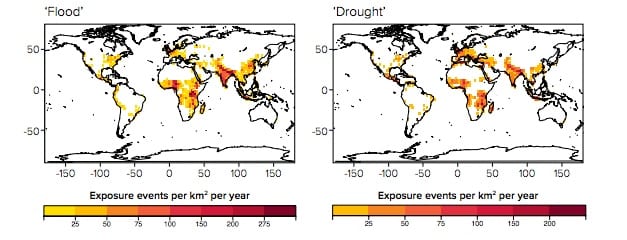Planning for the Future – Resilience to Extreme Weather
By Claire Asher, on 15 January 2015
As climate change progresses, extreme weather events are set to increase in frequency, costing billions and causing immeasurable harm to lives and livelihoods. GEE’s Professor Georgina Mace contributed to the recent Royal Society report on “Resilience to Extreme Weather”, which predicts the future impacts of increasing extreme weather events, and evaluates potential strategies for improving our ability to survive, even thrive, despite them.
Extreme weather events, such as floods, droughts and hurricanes, are predicted to increase in frequency and severity as the climate warms, and there is some evidence this is happening already. These extreme events come at a considerable cost both to people’s lives, health and wellbeing, and the economy. Between 1980 and 2004, extreme weather is estimated to have cost around US$1.5 trillion, and costs are rising. A recent report by the Royal Society reviews the future risks of extreme weather and the measures we can take to improve our resilience.

The global insured and uninsured economic losses from the two biggest categories of weather-related extreme events. Royal Society (2014)
Disaster risk is a combination of the likelihood of a particular disaster occurring and the impact on people and infrastructure. However, the impact will be influenced not only by the severity of the disaster, but by the vulnerability of the population and its infrastructure, a characteristic we have the potential to change. Thus, while it may be possible to reduce the frequency of disasters by reducing carbon emissions and slowing climate change, another key priority is to improve our own resilience against these events. Rather than just surviving extreme weather, we must adapt and transform.
The risks posed by climate change may be underestimated if exposure and vulnerability to extreme weather are not taken into account. Mapped climate and population projections for the next century show that the number of people exposed to floods, droughts and heatwaves will both increase and become more concentrated.
In their recent report, the Royal Society compared different approaches to increasing resilience to coastal flooding, river flooding, heatwaves and droughts. Overall, they found that a portfolio of defence options, including both physical and social techniques and those that utilise both traditional engineering solutions and more ecosystem based approaches. Broadly, approaches can be categorised as engineering, ecosystem-based, or hybrids of the two. Resilience strategies that incorporate natural ecosystems and processes tend to be more affordable and deliver wider societal benefits as well as simply reducing the immediate impact of the disaster.
Ecosystem-based approaches can take a variety of different forms, but often involve maintaining or improving natural ecosystems. For example … Large, intact tropical forests are important in climate regulation, flood and erosion management and … Forests can also act as a physical defence, and help to sustain livelihoods and provide resources for post-disaster recovery. Ecosystem-based approaches often require a lot of land and can take a long time to become established and effective, however in the long-term they tend to be more affordable and offer a wider range of benefits than engineering approaches. For this reason, they are often called ‘no regret’ options. Evidence for the effectiveness of different resilience strategies is highly varied. Engineered approaches are often well-established, with decades of strong research to back them up. In contrast, ecosystem approaches have been developed more recently and there is less evidence available on their effects. The Royal Society report indicates that for coastal flooding and drought, some of the most affordable and effective solutions are ecosystem-based, such as mangrove maintenance as a coastal defence and agroforestry to mitigate the effects of drought and maintain soil quality. In many situations, hybrid solutions may offer the best mixture of affordability and effectiveness.
It is crucial for governments to develop and implement resilience strategies and start building resilience now. This will be most effective if resilience measures are coordinated internationally, resources shared and where possible, cooperative measures implemented. By directing funds towards resilience-building, governments can reduce the need for costly disaster responses later. Governments can reduce the economic and human costs of extreme weather by focussing on minimising the consequences of infrastructure failure, rather than trying to avoid failure entirely. Prioritising essential infrastructure and focussing on minimising the harmful effects of extreme weather are likely to be the most effective approaches in preparing for future increases in extreme weather events.
Original Article:
 Close
Close




